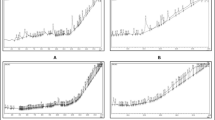Abstract
In this study, the chemical compositions and the anti-bacterial activities of hydrodistilled essential oils of the whole parts ofPeucedanum japonicum and the immature fruits ofCitrus unshiu were investigated. The chemical constituents of theP. Japonicum (PJE) andCitrus unshiu (CuE) essential oils were further analyzed by GC-MS and their major components were β-pinene (66.07%) and limonene (77.93%), respectively. The antibacterial activities of PJE and CuE against drug-susceptible and -resistant skin pathogens were also examined. Anti-bacterial tests using the disk diffusion method and the minimum inhibitory concentration (MIC) values indicated that PJE and CuE have excellent activities. The MIC of PJE against drug-susceptible and -resistant skin pathogens ranged from 0.13 to 5.0 μL/mL, whereas that of CuE ranged from 0.08 to 1.25 μL/mL. In addition, CuE reduced the lipopolysaccharide (LPS)-induced secretion of nitric oxide (NO) in RAW 264.7 cells, indicating that it has anti-inflammatory effects. These findings demonstrate that PJE and CuE have great potential for use in promoting human skin health.
Similar content being viewed by others
References
Baik J.S., Kim S.S., Lee J.A., Oh T.H., Kim J.Y., Lee N.H., Hyun C.G. (2008). Chemical composition and biological activities of essential oils isolated from Korean endemic Citrus species. J. Microbiol. Biotechnol., 18: 74–79.
Carson C.F, Riley T.V. (1995). Antimicrobial activity of the major components of the essential oil ofMelaleuca alternifolia. J. Appl. Bacteriol., 78: 264–269.
Costa E.V., Teixeira S.D., Marques F.A., Duarte M.C., Delarmelina C., Pinheiro M.L., Trigo J.R., Sales Maia B.H. (2008). Chemical composition and antimicrobial activity of the essential oils of the Amazon Guatteriopsis species. Phytochemistry, 69: 1895–1899.
Hisamoto M., Kikuzaki H., Nakatani N. (2004). Constituents of the leaves ofPeucedanum japonicum Thunb. and their biological activity. J. Agric. Food Chem., 52: 445–450.
Hisamoto M., Kikuzaki H., Ohigashi H., Nakatani N. (2003). Antioxidant compounds from the leaves ofPeucedanum Japonicum thunb. J. Agric. Food Chem., 51: 5255–5261.
Holland D.B., Bojar R.A., Jeremy A.H., Ingham E., Holland K.T. (2008). Microbial colonization of anin vitro model of a tissue engineered human skin equivalent-a novel approach. FEMS Microbiol. Lett., 279: 110–115.
Huong D.T., Choi H.C., Rho T.C., Lee H.S., Lee M.K., Kim Y.H. (1999). Inhibitory activity of monoamine oxidase by coumarins fromPeucedanum japonicum. Arch. Pharm. Res., 22: 324–326.
Kim S.S., Baik J.S., Oh T.H., Yoon W.J., Lee N.H., Hyun C.G. (2008). Biological activities of KoreanCitrus Obovoidea andCitrus natsudaidai essential oils against acne-inducing bacteria. Biosci. Biotechnol. Biochem., 72: 2507–2513.
Kelen M., Tepe B. (2007). Chemical composition, antioxidant and antimicrobial properties of the essential oils of three Salvia species from Turkish flora. Bioresour Technol., 99: 4096–4104.
Lee J.W., Roh T.C., Rho M.C., Kim Y.K., Lee H.S. (2002). Mechanisms of relaxant action of a pyranocoumarin fromPeucedanum japonicum in isolated rat thoracic aorta. Planta Med., 68: 891–895.
Lee S.O., Choi S.Z., Lee J.H., Chung S.H., Park S.H., Kang H.C., Yang E.Y., Cho H.J., Lee K.R. (2004). Antidiabetic coumarin and cyclitol compounds fromPeucedanum japonicum. Arch. Pharm. Res., 27: 1207–1210.
Lis-Balchin M., Deans S.G. (1997). Bioactivity of selected plant essential oils againstListeria monocytogenes, J. Appl. Bacteriol., 82: 759–762.
Malhotra S., Suri S., Tuli R. (2009) Antioxidant activity of citrus cultivars and chemical composition ofCitrus karma essential oil. Planta Med., 75: 62–64.
Mandalari G., Bennett R.N., Bisignano G., Trombetta D., Saija A., Faulds C.B., Gasson M.J., Narbad A. (2007) Antimicrobial activity of flavonoids extracted from bergamot (Citrus bergamia Risso) peel, a byproduct of the essential oil industry. J. Appl. Microbiol., 103: 2056–2064.
Morioka T., Suzui M., Nabandith V., Inamine M., Aniya Y., Nakayama T., Ichiba T., Mori H., Yoshimi N. (2004). The modifying effect ofPeucedanum japonicum, a herb in the Ryukyu Islands, on azoxymethane-induced colon preneoplastic lesions in male F344 rats. Cancer Lett., 205: 133–141.
Papadopoulos C.J., Carson C.F., Hammer K.A., Riley T.V. (2006). Susceptibility of pseudomonads toMelaleuca Alternifolia (tea tree) oil and components. J. Antimicrob. Chemother., 58: 449–451.
Tepe B., Donmez E., Unlu M., Candan F., Daferera D., Vardar-unlu G., Polissiou M., Sokmen A. (2004). Antimicrobial and antioxidative activities of the essential oils and methanol extracts ofSalvia cryptantha (Montbret et Aucher ex Benth.) andSalvia Multicaulis (Vahl). Food Chem., 84: 519–525.
Tepe B., Sokmen M., Sokmen A., Daferera D., Polissiou M. (2005). Antimicrobial and antioxidative activity of the essential oil and various extracts ofCyclotrichium origanifolium (Labill.) Manden. & Scheng. J. Food Eng., 69: 335–342.
Vukovic N., Milosevic T., Sukdolak S., Solujic S. (2007). Antimicrobial activities of essential oil and methanol extract ofTeucrium montanum. Evid. Based Complement. Alternat. Med., 4: 17–20.
Walsh C., Fanning S. (2008). Antimicrobial resistance in foodborne pathogens — a cause for concern? Curr. Drug Targets, 9: 808–815.
Yajima I., Yanai T., Nakamura M., Hayashi K. (1979) Compositions of the volatiles of peel oil and juice fromCitrus unshiu. Agric. Biol. Chem., 43: 259–264.
Yoon W.J., Kim S.S., Oh T.H., Lee N.H., Hyun C.G. (2009).Cryptomeria japonica essential oil inhibits the growth of drug-resistant skin pathogens and LPS-induced nitric oxide and pro-inflammatory cytokine production. Pol. J. Microbiol., 58: 61–68.
Author information
Authors and Affiliations
Corresponding author
Additional information
These authors contributed equally to this work
Rights and permissions
About this article
Cite this article
Yang, EJ., Kim, SS., Oh, TH. et al. Peucedanum japonicum andCitrus unshiu essential oils inhibit the growth of antibiotic-resistant skin pathogens. Ann. Microbiol. 59, 623–628 (2009). https://doi.org/10.1007/BF03175155
Received:
Accepted:
Issue Date:
DOI: https://doi.org/10.1007/BF03175155




